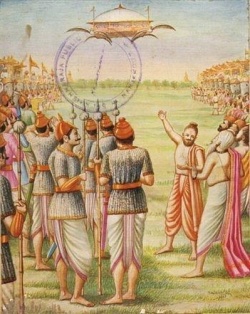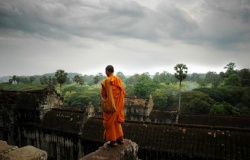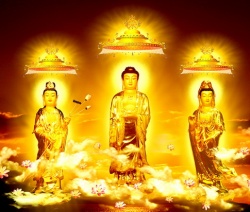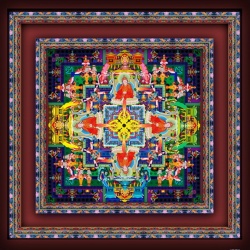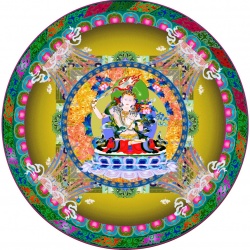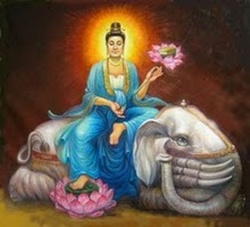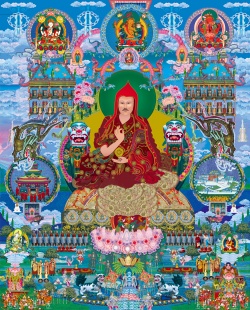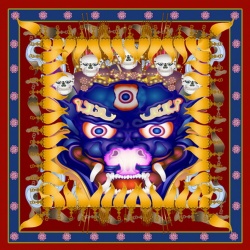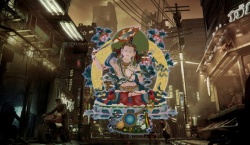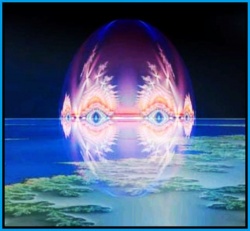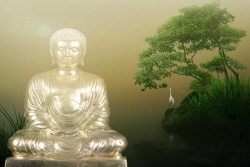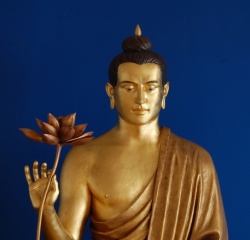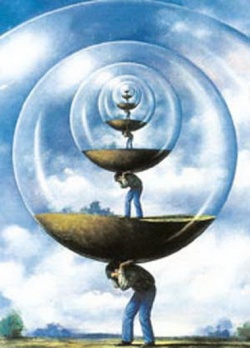Difference between revisions of "Avadāna"
| Line 1: | Line 1: | ||
{{DisplayImages|861|1505|53|1547|1608|1190|1303|1878|1327|1414|943|1998|1374|381|521|2088|1559|1137}} | {{DisplayImages|861|1505|53|1547|1608|1190|1303|1878|1327|1414|943|1998|1374|381|521|2088|1559|1137}} | ||
<poem> | <poem> | ||
| + | |||
| + | |||
| + | |||
| + | |||
| + | |||
| + | |||
| + | |||
The [[Jātakamālā]] is also called [[Bodhisattva Avadānamālā]], for [[Bodhisattva Avadāna]] is {{Wiki|synonymous}} with [[Jātaka]]. The [[Jātakas]] are consequently nothing but [[Avadānas]] having the [[Bodhisattva]] for their [[hero]]. Connsequently works like the [[Sūtrālaṁkāra]] and the [[Jātakamālā]] have much in common with the texts of the [[Avadāna]] {{Wiki|literature}}. On the other hand numerous [[Jātakas]] are to be found in the collections of [[Avadānas]]. | The [[Jātakamālā]] is also called [[Bodhisattva Avadānamālā]], for [[Bodhisattva Avadāna]] is {{Wiki|synonymous}} with [[Jātaka]]. The [[Jātakas]] are consequently nothing but [[Avadānas]] having the [[Bodhisattva]] for their [[hero]]. Connsequently works like the [[Sūtrālaṁkāra]] and the [[Jātakamālā]] have much in common with the texts of the [[Avadāna]] {{Wiki|literature}}. On the other hand numerous [[Jātakas]] are to be found in the collections of [[Avadānas]]. | ||
| Line 15: | Line 22: | ||
Like the [[jātakas]] the [[avadānas]] also are a {{Wiki|species}} of [[sermons]]. It is accordingly usually related by way of an introduction where and on what [[occasion]] the [[Buddha]] narrated the story of the {{Wiki|past}} and at the close the [[Buddha]] draws from the story the [[moral]] of his [[doctrine]]. Hence a regular [[avadāna]] consists of a story of the {{Wiki|present}}, a story of the {{Wiki|past}} and a [[moral]]. If the [[hero]] of the story of the {{Wiki|past}} is a [[Bodhisattva]] the [[avadāna]] can also be designated a [[jātaka]]. | Like the [[jātakas]] the [[avadānas]] also are a {{Wiki|species}} of [[sermons]]. It is accordingly usually related by way of an introduction where and on what [[occasion]] the [[Buddha]] narrated the story of the {{Wiki|past}} and at the close the [[Buddha]] draws from the story the [[moral]] of his [[doctrine]]. Hence a regular [[avadāna]] consists of a story of the {{Wiki|present}}, a story of the {{Wiki|past}} and a [[moral]]. If the [[hero]] of the story of the {{Wiki|past}} is a [[Bodhisattva]] the [[avadāna]] can also be designated a [[jātaka]]. | ||
| − | A particular {{Wiki|species}} of [[avadānas]] are those in which the [[Buddha]] instead of a story of the {{Wiki|past}} relates a {{Wiki|prognostication}} of the {{Wiki|future}}. These prophetic anecdotes serve like the stories of the {{Wiki|past}} to explain the {{Wiki|present}} [[karma]]. There are besides [[avadānas]] in which both the parties of the stories are united and finally there is a class in which a [[karma]] shows good or [[evil]] consequence in the {{Wiki|present}} [[existence]]. All these {{Wiki|species}} of [[avadānas]] occur sporadically also in the [[Vinaya]] and the [[Sūtra]] [[piṭakas]]. They however, are grouped in large collections with the [[object]] of edification or for more ambitious {{Wiki|literary}} motives. A work of the first variety is the [[Avadānaśataka]] which is most probably the most {{Wiki|ancient}} of its kind. It is a collection of a hundred [[avadāna]] {{Wiki|legends}}. Since it was already rendered into {{Wiki|Chinese}} in the first half of the 3rd century and since it makes mention of the [[dinara]] we may with tolerable {{Wiki|certainty}} assign it to the second {{Wiki|Christian}} century. That it belongs to the [[Hīnayāna]] is indicated already by the [[character]] [47] of the anecdotes; but this is likewise corroborated by the circumstances that in the stories relating to the {{Wiki|present}} there are fragments [[embodied]] from the [[Sanskrit]] [[canon]] of the Sārvāstivādis relating to the [[Parinirvāṇa]] and other [[sūtras]]. In these {{Wiki|legends}} the {{Wiki|worship}} of the [[Buddha]] plays a great part. There is no trace in them, however, of the [[Bodhisattva]] {{Wiki|cult}} or of any [[Mahāyānistic]] [[mythology]]. | + | A particular {{Wiki|species}} of [[avadānas]] are those in which the [[Buddha]] instead of a story of the {{Wiki|past}} relates a {{Wiki|prognostication}} of the {{Wiki|future}}. These prophetic anecdotes serve like the stories of the {{Wiki|past}} to explain the {{Wiki|present}} [[karma]]. There are besides [[avadānas]] in which both the parties of the stories are united and finally there is a class in which a [[karma]] shows good or [[evil]] consequence in the {{Wiki|present}} [[existence]]. All these {{Wiki|species}} of [[avadānas]] occur sporadically also in the [[Vinaya]] and the [[Sūtra]] [[piṭakas]]. They however, are grouped in large collections with the [[object]] of edification or for more ambitious {{Wiki|literary}} motives. A work of the first variety is the [[Avadānaśataka]] which is most probably the most {{Wiki|ancient}} of its kind. It is a collection of a hundred [[avadāna]] {{Wiki|legends}}. Since it was already rendered into {{Wiki|Chinese}} in the first half of the 3rd century and since it makes mention of the [[dinara]] we may with tolerable {{Wiki|certainty}} assign it to the second {{Wiki|Christian}} century. That it belongs to the [[Hīnayāna]] is indicated already by the [[character]] [47] of the anecdotes; but this is likewise corroborated by the circumstances that in the stories relating to the {{Wiki|present}} there are fragments [[embodied]] from the [[Sanskrit]] [[canon]] of the [[Sārvāstivādis]] relating to the [[Parinirvāṇa]] and other [[sūtras]]. In these {{Wiki|legends}} the {{Wiki|worship}} of the [[Buddha]] plays a great part. There is no trace in them, however, of the [[Bodhisattva]] {{Wiki|cult}} or of any [[Mahāyānistic]] [[mythology]]. |
[[Avadānaśātaka]] | [[Avadānaśātaka]] | ||
| Line 23: | Line 30: | ||
Here an act of piety is related by which a [[person]] - a [[Brahman]], a {{Wiki|princess}}, the son of an usurer, a wealthy {{Wiki|merchant}}, a gardener, a [[king]], a ferry man, a young maiden and so forth - makes adoration to the [[Buddha]] which usually leads to the occurrence of some kind of [[miracle]], and then the [[Buddha]] with a [[smile]] reveals that the particular [[person]] in a {{Wiki|future}} age will become a [[Buddha]] or (in the Third [[book]]) a [[Pratyeka Buddha]]. On the other hand the histories in the Second and in the Fourth decades are [[Jātakas]]. With regard to the saintly [[virtues]] and astounding acts, it is explained that the [[hero]] of these tales was no other than the [[Buddha]] himself in one of his earlier [[births]]. | Here an act of piety is related by which a [[person]] - a [[Brahman]], a {{Wiki|princess}}, the son of an usurer, a wealthy {{Wiki|merchant}}, a gardener, a [[king]], a ferry man, a young maiden and so forth - makes adoration to the [[Buddha]] which usually leads to the occurrence of some kind of [[miracle]], and then the [[Buddha]] with a [[smile]] reveals that the particular [[person]] in a {{Wiki|future}} age will become a [[Buddha]] or (in the Third [[book]]) a [[Pratyeka Buddha]]. On the other hand the histories in the Second and in the Fourth decades are [[Jātakas]]. With regard to the saintly [[virtues]] and astounding acts, it is explained that the [[hero]] of these tales was no other than the [[Buddha]] himself in one of his earlier [[births]]. | ||
| − | A kind of [[Pretavastu]], corresponding to the [[Pāḷi]] [[Petavatthu]], is represented by the Fifth [[book]]. A [[saint]] - usually it is [[Maudgalyayāna]] - proceeds to the [[world]] of [[spirits]] and observes the sorrows of one of its denizens, ([[pretas]]) {{Wiki|male}} or [48] {{Wiki|female}}. He questions the [[spirit]] regarding the [[cause]] of his tribulation. The [[spirit]] refers him to the [[Buddha]], and the [[latter]] then narrates the history of the “black [[deed]]" - the refusal to give [[alms]], offence to a [[saint]], etc. - which this creature perpetrated in his previous [[birth]]. | + | A kind of [[Pretavastu]], [[corresponding]] to the [[Pāḷi]] [[Petavatthu]], is represented by the Fifth [[book]]. A [[saint]] - usually it is [[Maudgalyayāna]] - proceeds to the [[world]] of [[spirits]] and observes the sorrows of one of its denizens, ([[pretas]]) {{Wiki|male}} or [48] {{Wiki|female}}. He questions the [[spirit]] regarding the [[cause]] of his tribulation. The [[spirit]] refers him to the [[Buddha]], and the [[latter]] then narrates the history of the “black [[deed]]" - the refusal to give [[alms]], offence to a [[saint]], etc. - which this creature perpetrated in his previous [[birth]]. |
The Sixth [[book]] relates histories of men and {{Wiki|beasts}} that through some pious act are born as [[deities]] in [[heaven]]. The last four decades narrate stories purporting to show the [[nature]] of acts which lead to [[Arhatship]]. The [[Arhats]] of the Seventh [[book]] are all derived from the [[Śākya]] {{Wiki|clan}}; those of the Eighth [[book]] are all women; those of the Ninth are persons of irreproachable conduct; and those of the Tenth are men who in former days committed [[evil]] [[deeds]] and [[suffered]] in consequence and subsequently owing to an act of [[virtue]] [[attained]] to the [[state]] of an [[Arhat]]. | The Sixth [[book]] relates histories of men and {{Wiki|beasts}} that through some pious act are born as [[deities]] in [[heaven]]. The last four decades narrate stories purporting to show the [[nature]] of acts which lead to [[Arhatship]]. The [[Arhats]] of the Seventh [[book]] are all derived from the [[Śākya]] {{Wiki|clan}}; those of the Eighth [[book]] are all women; those of the Ninth are persons of irreproachable conduct; and those of the Tenth are men who in former days committed [[evil]] [[deeds]] and [[suffered]] in consequence and subsequently owing to an act of [[virtue]] [[attained]] to the [[state]] of an [[Arhat]]. | ||
| Line 43: | Line 50: | ||
{{Wiki|Culture}} Evidences | {{Wiki|Culture}} Evidences | ||
| − | A pious man, an opulent personage, a mighty sovereign, a [[happy]] [[wedding]], the up-bringing of a young man, the [[appearance]] of an earlier [[Buddha]] and similar recurring [[phenomena]] are ever described in stereotyped terms. Nor is this applicable only to a few brief sentences. It holds good for extensive pieces covering several pages of print. One of the longest of these fixture pieces describes the [[smile]] of the [[Buddha]] with which the [[latter]] lays down that every one can attain to the [[state]] of a [[Buddha]]. The [[Buddha]] always is moved to a [[smile]] before he [[prophesies]] the {{Wiki|future}}. When he [[smiles]] from his {{Wiki|mouth}} issue rays of blue, yellow, red and white. One of these beams of {{Wiki|light}} go down to the depths of inferno the others are darted heavenwards. After encircling thousands and thousands of [[worlds]] they return back to the [[Buddha]] and disappear into some one or the other of the parts of the [[Buddha's]] [[body]] according to the [[nature]] of the vaticination; and all this is delineated to the minutest particular. This circumstantiality and the minutiae are [[characteristic]] of the {{Wiki|narrative}} mode of the [[Avadānaśataka]]. However together with much that is banal and wearisome we always get edifying stories and many valuable anecdotes and noteworthy variants to other stories accessible to us from other portions of [[Buddhist]] {{Wiki|narrative}} {{Wiki|literature}}. [50] We can cite only a few examples in order to give an [[idea]] of the [[character]] of this remarkable collection of [[Buddhist]] {{Wiki|folklore}}. Here are some [[characteristic]] stories in which the true {{Wiki|social}} [[life]] of [[India]] is mirrored. | + | A pious man, an opulent personage, a mighty sovereign, a [[happy]] [[wedding]], the up-bringing of a young man, the [[appearance]] of an earlier [[Buddha]] and similar recurring [[phenomena]] are ever described in stereotyped terms. Nor is this applicable only to a few brief sentences. It holds good for extensive pieces covering several pages of print. One of the longest of these fixture pieces describes the [[smile]] of the [[Buddha]] with which the [[latter]] lays down that every one can attain to the [[state]] of a [[Buddha]]. The [[Buddha]] always is moved to a [[smile]] before he [[prophesies]] the {{Wiki|future}}. When he [[smiles]] from his {{Wiki|mouth}} issue rays of blue, [[yellow]], [[red]] and white. One of these beams of {{Wiki|light}} go down to the depths of inferno the others are darted heavenwards. After encircling thousands and thousands of [[worlds]] they return back to the [[Buddha]] and disappear into some one or the other of the parts of the [[Buddha's]] [[body]] according to the [[nature]] of the vaticination; and all this is delineated to the minutest particular. This circumstantiality and the minutiae are [[characteristic]] of the {{Wiki|narrative}} mode of the [[Avadānaśataka]]. However together with much that is banal and wearisome we always get edifying stories and many valuable anecdotes and noteworthy variants to other stories accessible to us from other portions of [[Buddhist]] {{Wiki|narrative}} {{Wiki|literature}}. [50] We can cite only a few examples in order to give an [[idea]] of the [[character]] of this remarkable collection of [[Buddhist]] {{Wiki|folklore}}. Here are some [[characteristic]] stories in which the true {{Wiki|social}} [[life]] of [[India]] is mirrored. |
Maiden [[Disciple]]: Story 28 | Maiden [[Disciple]]: Story 28 | ||
| Line 59: | Line 66: | ||
{{Wiki|Princess}} Devout: Story 54 | {{Wiki|Princess}} Devout: Story 54 | ||
| − | At the suggestion of his {{Wiki|princess}}, [[king]] [[Bimbisāra]] set up a [[Stūpa]] in his seraglio over some [[hair]] and {{Wiki|nails}} presented to him by the [[Buddha]]. The [[Stūpa]] was worshipped by the women with [[incense]], lamps, [[flowers]], etc. But when {{Wiki|prince}} [[Ajātaśatru]] assassinated his father [[Bimbisāra]] and himself ascended the [[throne]], he gave strict orders that no lady of of his {{Wiki|harem}} should, on [[pain]] of [[death]], venerate the [[shrine]]. [[Śrimatī]], however, who was one of the ladies in the {{Wiki|harem}}, did not obey the command and laid a garland of lights round the [[Stūpa]]. The infuriated [[king]] put her to [[death]]. She [[died]] with the [[thought]] of the [[Buddha]] in her [[mind]] and was immediately translated to [[heaven]] as a [[divinity]]. | + | At the suggestion of his {{Wiki|princess}}, [[king]] [[Bimbisāra]] set up a [[Stūpa]] in his seraglio over some [[hair]] and {{Wiki|nails}} presented to him by the [[Buddha]]. The [[Stūpa]] was worshipped by the women with [[incense]], lamps, [[flowers]], etc. But when {{Wiki|prince}} [[Ajātaśatru]] assassinated his father [[Bimbisāra]] and himself ascended the [[throne]], he gave strict orders that no lady of of his {{Wiki|harem}} should, on [[pain]] of [[death]], venerate the [[shrine]]. [[Śrimatī]], however, who was one of the ladies in the {{Wiki|harem}}, did not obey the command and laid a [[garland]] of lights round the [[Stūpa]]. The infuriated [[king]] put her to [[death]]. She [[died]] with the [[thought]] of the [[Buddha]] in her [[mind]] and was immediately translated to [[heaven]] as a [[divinity]]. |
Guerdon of Service to [[Buddha]]: Story 100 | Guerdon of Service to [[Buddha]]: Story 100 | ||
| − | While the heroes of all the [[Avadānas]] are the [[Buddha's]] contemporaries, the [[hero]] of this last story is a [[person]] who lived in the times of [[king]] [[Aśoka]]. The connection with the [[time]] of the [[Buddha]] is established by the insertion of an account of the decease of the [[Buddha]]. This {{Wiki|narrative}} piece is extracted from a [[Parinirvāṇasūtra]] and is in tolerable accord with the celebrated [[Pāḷi]] [[Mahaparinibbānasutta]] (another passage from the [[Parinirvāṇasūtra]] serves as an introduction to Story No. 40). | + | While the heroes of all the [[Avadānas]] are the [[Buddha's]] contemporaries, the [[hero]] of this last story is a [[person]] who lived in the times of [[king]] [[Aśoka]]. The [[connection]] with the [[time]] of the [[Buddha]] is established by the insertion of an account of the decease of the [[Buddha]]. This {{Wiki|narrative}} piece is extracted from a [[Parinirvāṇasūtra]] and is in tolerable accord with the celebrated [[Pāḷi]] [[Mahaparinibbānasutta]] (another passage from the [[Parinirvāṇasūtra]] serves as an introduction to Story No. 40). |
A hundred years after the passing of the [[Buddha]] lived [[king]] [[Aśoka]]. He had a son named [[Kuṇāla]] who was so [52] [[charming]] that the [[king]] [[thought]] he had no {{Wiki|equal}} in the [[world]]. One day, however, he learnt from {{Wiki|merchants}} from [[Gandhāra]] that there were still more handsome young men than the {{Wiki|prince}} in their country. According to the {{Wiki|merchants}} there was living a youth called [[Sundara]] who was not only of irreproachable [[beauty]], but wherever he turned, there sprang up a lotus-pond and a [[garden]]. The astonished [[king]] [[Aśoka]] sent a messenger and invited [[Sundara]] and satisfied himself about this [[wonder]]. The [[king]] asked to what [[karma]] the youth owed his [[excellence]] and the [[Elder Upagupta]] gave the explanation. At the [[time]] that the [[Buddha]] had just [[attained]] to complete [[Nirvāṇa]] the {{Wiki|present}} [[Sundara]] was an impoverished peasant who prepared a refreshing bath and revived with [[food]] [[Mahakāśyapa]] and his suite of 500 [[monks]] who had performed the obsequies of the [[Master]], who were {{Wiki|depressed}} with [[sorrow]] at the passing of the [[Lord]] and who had been exhausted with the long journey. [[Sundara]] was now enjoying the fruit of this his good [[deed]]. | A hundred years after the passing of the [[Buddha]] lived [[king]] [[Aśoka]]. He had a son named [[Kuṇāla]] who was so [52] [[charming]] that the [[king]] [[thought]] he had no {{Wiki|equal}} in the [[world]]. One day, however, he learnt from {{Wiki|merchants}} from [[Gandhāra]] that there were still more handsome young men than the {{Wiki|prince}} in their country. According to the {{Wiki|merchants}} there was living a youth called [[Sundara]] who was not only of irreproachable [[beauty]], but wherever he turned, there sprang up a lotus-pond and a [[garden]]. The astonished [[king]] [[Aśoka]] sent a messenger and invited [[Sundara]] and satisfied himself about this [[wonder]]. The [[king]] asked to what [[karma]] the youth owed his [[excellence]] and the [[Elder Upagupta]] gave the explanation. At the [[time]] that the [[Buddha]] had just [[attained]] to complete [[Nirvāṇa]] the {{Wiki|present}} [[Sundara]] was an impoverished peasant who prepared a refreshing bath and revived with [[food]] [[Mahakāśyapa]] and his suite of 500 [[monks]] who had performed the obsequies of the [[Master]], who were {{Wiki|depressed}} with [[sorrow]] at the passing of the [[Lord]] and who had been exhausted with the long journey. [[Sundara]] was now enjoying the fruit of this his good [[deed]]. | ||
| Line 81: | Line 88: | ||
[[Characteristics]] | [[Characteristics]] | ||
| − | This collection of stories, of great importance for the history of [[Indian]] {{Wiki|sociology}}, begins with the [[Mahāyānistic]] benediction, “Oh, reverence to all the [[exalted]] [[Buddhas]] and [[Bodhisattvas]]” and contains a few obviously later accretions in the [[Mahāyānistic]] [[sense]]. As a whole, however, the [[book]] decidedly belongs to the [[Hīnayāna]] school. As the example of the [[Mahāyānistic]] interpolation we may mention [[chapter]] XXXIV which is noted in the collection itself as a [[Mahāyānasūtra]] (p. 483). In [[chapter]] XXX there occurs the [[ṣadakṣaravidya]] or the well-known [[Tibetan]] [[formula]] of [54] [[om mani padme hum]] ([[Wikipedia:Louis de La Vallée-Poussin|Poussin]], Boudhisme p. 381). The [[Sanskrit]] [[canon]] of [[Buddhism]] is repeatedly mentioned and {{Wiki|individual}} canonic texts are quoted such as [[Dīrghāgama]], [[Udāna]], [[Sthaviragāthā]] ([[Oldenberg]], Zeitschift der Deutschen Morgenlandischen Gesellschaft 52,1891, pp. 653, 655 f., 658, 665). It mentions the four [[Āgamas]] (p. 333). Many of the stories commence and terminate exactly as in the [[Avadānaśataka]]. And finally a number of stereotyped phrases and descriptions, so [[characteristic]], appear again in self-same words in the [[Divyāvadāna]]. In all {{Wiki|probability}} they are derived from the common source - the [[Vinayapiṭaka]] of the [[Sārvāstivādis]]. As a {{Wiki|matter}} of fact, more than half of the anecdotes have been borrowed from the [[latter]] but several have been loans from the [[Sūtrālaṁkāra]] of [[Aśvaghoṣa]] which we discussed above (Huber Bulletin de l'Ecole Francaise d'Extreme {{Wiki|Orient}} IV, 1904, 709 ff.; VI, 1906, 1 ff.; {{Wiki|Sylvain Levi}} T'oung Pao, V.VII, 1907, 105 ff., and Speyer [[Avadānaśataka]] II, preface p. XVI f.). | + | This collection of stories, of great importance for the history of [[Indian]] {{Wiki|sociology}}, begins with the [[Mahāyānistic]] [[benediction]], “Oh, reverence to all the [[exalted]] [[Buddhas]] and [[Bodhisattvas]]” and contains a few obviously later accretions in the [[Mahāyānistic]] [[sense]]. As a whole, however, the [[book]] decidedly belongs to the [[Hīnayāna]] school. As the example of the [[Mahāyānistic]] interpolation we may mention [[chapter]] XXXIV which is noted in the collection itself as a [[Mahāyānasūtra]] (p. 483). In [[chapter]] XXX there occurs the [[ṣadakṣaravidya]] or the well-known [[Tibetan]] [[formula]] of [54] [[om mani padme hum]] ([[Wikipedia:Louis de La Vallée-Poussin|Poussin]], Boudhisme p. 381). The [[Sanskrit]] [[canon]] of [[Buddhism]] is repeatedly mentioned and {{Wiki|individual}} canonic texts are quoted such as [[Dīrghāgama]], [[Udāna]], [[Sthaviragāthā]] ([[Oldenberg]], Zeitschift der Deutschen Morgenlandischen Gesellschaft 52,1891, pp. 653, 655 f., 658, 665). It mentions the four [[Āgamas]] (p. 333). Many of the stories commence and terminate exactly as in the [[Avadānaśataka]]. And finally a number of stereotyped phrases and descriptions, so [[characteristic]], appear again in self-same words in the [[Divyāvadāna]]. In all {{Wiki|probability}} they are derived from the common source - the [[Vinayapiṭaka]] of the [[Sārvāstivādis]]. As a {{Wiki|matter}} of fact, more than half of the anecdotes have been borrowed from the [[latter]] but several have been loans from the [[Sūtrālaṁkāra]] of [[Aśvaghoṣa]] which we discussed above (Huber Bulletin de l'Ecole Francaise d'Extreme {{Wiki|Orient}} IV, 1904, 709 ff.; VI, 1906, 1 ff.; {{Wiki|Sylvain Levi}} T'oung Pao, V.VII, 1907, 105 ff., and Speyer [[Avadānaśataka]] II, preface p. XVI f.). |
Analysis of Components | Analysis of Components | ||
| − | The [[Divyāvadāna]] is composed of very varied materials. It has no [[principle]] of [[division]], nor is it {{Wiki|uniform}} with regard to [[language]] and style. Most of the {{Wiki|legends}} are written in good simple [[Sanskrit]] prose which is only here and there interrupted by [[gāthās]]. But in some passages we find also elaborate [[poetry]] of genuine [[Kāvya]] style with long compounds. The editor of this collection of {{Wiki|legends}} appears, therefore, to have simply pieced together a variety of stories from other texts. From this also follows that the several component [[elements]] of the work are assignable to different periods of [[time]]. If our collection, as has been alleged, was already translated into {{Wiki|Chinese}} in the third {{Wiki|Christian}} century it could not have been published in the original long before that date. At the same [[time]] we have to bear in [[mind]] that because some of the [[Avadānas]] in the [[Divyāvadāna]] were translated into {{Wiki|Chinese}} in the third century (Cowell Neil, p. 655,), therefore it does not necessarily follow that the work as a whole was rendered into {{Wiki|Chinese}} (Kern Manual, p. 10; Barth, Revue de l'Histoire des [[Religions]] 889, V. 19, p. 260). Not only there is the mention of the successors of [[Aśoka]], the [[kings]] of the Śuṅga {{Wiki|dynasty}} down to the [55] Puśyamitra (178 B.C.) but there is the repeated occurrence of the [[dinara]], which brings us down to the second century. And some period after [[Aśvaghoṣa]] must have elapsed before a compiler could take extracts from his [[Sūtrālaṁkāra]] for his [[own]] {{Wiki|anthology}}. The [[Divyāvadāna]], therefore, was redacted rather in the third than in the second century. Nevertheless it is remarkable that just one of the most [[interesting]] {{Wiki|legends}} in the [[Divyāvadāna]], the story of Śārdūlakarṇa, was translated into {{Wiki|Chinese}} in 265 A.D. The contents of this [[Avadāna]] noteworthy in many respects, are as follows:- | + | The [[Divyāvadāna]] is composed of very varied materials. It has no [[principle]] of [[division]], nor is it {{Wiki|uniform}} with regard to [[language]] and style. Most of the {{Wiki|legends}} are written in good simple [[Sanskrit]] prose which is only here and there interrupted by [[gāthās]]. But in some passages we find also elaborate [[poetry]] of genuine [[Kāvya]] style with long compounds. The editor of this collection of {{Wiki|legends}} appears, therefore, to have simply pieced together a variety of stories from other texts. From this also follows that the several component [[elements]] of the work are assignable to different periods of [[time]]. If our collection, as has been alleged, was already translated into {{Wiki|Chinese}} in the third {{Wiki|Christian}} century it could not have been published in the original long before that date. At the same [[time]] we have to bear in [[mind]] that because some of the [[Avadānas]] in the [[Divyāvadāna]] were translated into {{Wiki|Chinese}} in the third century (Cowell Neil, p. 655,), therefore it does not necessarily follow that the work as a whole was rendered into {{Wiki|Chinese}} (Kern Manual, p. 10; Barth, Revue de l'Histoire des [[Religions]] 889, V. 19, p. 260). Not only there is the mention of the successors of [[Aśoka]], the [[kings]] of the Śuṅga {{Wiki|dynasty}} down to the [55] [[Puśyamitra]] (178 B.C.) but there is the repeated occurrence of the [[dinara]], which brings us down to the second century. And some period after [[Aśvaghoṣa]] must have elapsed before a compiler could take extracts from his [[Sūtrālaṁkāra]] for his [[own]] {{Wiki|anthology}}. The [[Divyāvadāna]], therefore, was redacted rather in the third than in the second century. Nevertheless it is remarkable that just one of the most [[interesting]] {{Wiki|legends}} in the [[Divyāvadāna]], the story of Śārdūlakarṇa, was translated into {{Wiki|Chinese}} in 265 A.D. The contents of this [[Avadāna]] noteworthy in many respects, are as follows:- |
Śārdūlakarṇa: [[Love]] of the Untouchable | Śārdūlakarṇa: [[Love]] of the Untouchable | ||
| − | The [[Master]] was sojourning in [[Śrāvastī]] and [[Ānanda]] was wont daily to repair to the town on his begging round. Once upon a [[time]], as he was returning from the town, he became thirsty and [met] a [[caṇḍāla]] maiden, named Parakti, fetching [[water]] from a well. “Sister,” said he to her, “give me some [[water]] to drink.” Parakti replied, “I am a [[caṇḍāla]] girl, revered [[Ānanda]].” “Sister,” said [[Ānanda]], “I do not ask you about your family and your [[caste]], but if you have any [[water]] left, give it to me and I will drink.” (Note that so far the similarity with {{Wiki|Jesus}} and the Samariitan woman is surprising, John 4, 7 ff., but the whole course of the {{Wiki|narrative}} further down in the {{Wiki|Gospel}} is so different that we can scarcely think of any connection between the [[Buddhist]] and {{Wiki|Christian Scriptures}}). The maiden hands him the [[water]] to drink and falls deep in [[love]] with the [[Saint]]. She tells her mother that she will [[die]] or have [[Ānanda]] for her husband. The mother, who was a powerful witch, prepared a potent philtre and attempted her {{Wiki|sorcery}} on [[Ānanda]] with [[mantras]]. The process is described in a way similar to the incantation in the Kauśikasūtra of the {{Wiki|Atharvaveda}}. The charm is successful. [[Ānanda]] comes into the house of the [[caṇḍāla]] where the [[joyful]] Prakti [56] has prepared a bed. But in the [[moment]] of supreme [[danger]], [[Ānanda]] breaks out into {{Wiki|tears}} and supplicates the [[Buddha]] in his {{Wiki|distress}}. The [[latter]] hastens to his succour with his [[own]] counter [[mantras]]. [[Ānanda]] leaves the [[caṇḍāla]] home and returns to his [[monastery]]. The great witch declares to her unfortunate daughter that the {{Wiki|necromancy}} of [[Gautama]] is {{Wiki|superior}} to her [[own]]. But Prakti, the [[caṇḍāla]] maiden, was yet not cured of her [[love]]. She went into the town and followed [[Ānanda]] day after day as he went forth on his mendicant's circuit. Once more [[Ānanda]] in his [[sorrow]] turned to the [[Master]] for help. The [[latter]] summoned Prakti to himself and ostensibly consented to her [[desire]] that [[Ānanda]] should be her husband. Soon, however, he brings her to a frame of [[mind]] in which she takes the [[vow]] of spinsterly {{Wiki|chastity}} and turns a [[nun]]. She not only has her [[hair]] shaven and dons the [[nun's]] weeds, but dives into the profundity of the [[four Noble Truths]] and [[understands]] the [[religion]] of the [[Buddha]] in its entirety. | + | The [[Master]] was sojourning in [[Śrāvastī]] and [[Ānanda]] was wont daily to repair to the town on his begging round. Once upon a [[time]], as he was returning from the town, he became thirsty and [met] a [[caṇḍāla]] maiden, named Parakti, fetching [[water]] from a well. “Sister,” said he to her, “give me some [[water]] to drink.” Parakti replied, “I am a [[caṇḍāla]] girl, revered [[Ānanda]].” “Sister,” said [[Ānanda]], “I do not ask you about your [[family]] and your [[caste]], but if you have any [[water]] left, give it to me and I will drink.” (Note that so far the similarity with {{Wiki|Jesus}} and the Samariitan woman is surprising, John 4, 7 ff., but the whole course of the {{Wiki|narrative}} further down in the {{Wiki|Gospel}} is so different that we can scarcely think of any [[connection]] between the [[Buddhist]] and {{Wiki|Christian Scriptures}}). The maiden hands him the [[water]] to drink and falls deep in [[love]] with the [[Saint]]. She tells her mother that she will [[die]] or have [[Ānanda]] for her husband. The mother, who was a powerful witch, prepared a potent philtre and attempted her {{Wiki|sorcery}} on [[Ānanda]] with [[mantras]]. The process is described in a way similar to the incantation in the Kauśikasūtra of the {{Wiki|Atharvaveda}}. The charm is successful. [[Ānanda]] comes into the house of the [[caṇḍāla]] where the [[joyful]] Prakti [56] has prepared a bed. But in the [[moment]] of supreme [[danger]], [[Ānanda]] breaks out into {{Wiki|tears}} and supplicates the [[Buddha]] in his {{Wiki|distress}}. The [[latter]] hastens to his succour with his [[own]] counter [[mantras]]. [[Ānanda]] leaves the [[caṇḍāla]] home and returns to his [[monastery]]. The great witch declares to her unfortunate daughter that the {{Wiki|necromancy}} of [[Gautama]] is {{Wiki|superior}} to her [[own]]. But Prakti, the [[caṇḍāla]] maiden, was yet not cured of her [[love]]. She went into the town and followed [[Ānanda]] day after day as he went forth on his mendicant's circuit. Once more [[Ānanda]] in his [[sorrow]] turned to the [[Master]] for help. The [[latter]] summoned Prakti to himself and ostensibly consented to her [[desire]] that [[Ānanda]] should be her husband. Soon, however, he brings her to a frame of [[mind]] in which she takes the [[vow]] of spinsterly {{Wiki|chastity}} and turns a [[nun]]. She not only has her [[hair]] shaven and dons the [[nun's]] weeds, but dives into the profundity of the [[four Noble Truths]] and [[understands]] the [[religion]] of the [[Buddha]] in its entirety. |
When, however, the [[Brahmans]], {{Wiki|warriors}} and citizens of [[Śrāvastī]] heard that the [[Buddha]] made a [[caṇḍāla]] daughter a [[nun]], they were greatly perturbed, conveyed it to the [[king]] Praśenajit and the [[latter]] immediately set out for the [[Master]] to remonstrate with him. Numerous [[Brahmans]], {{Wiki|warriors}} and citizens of [[Śrāvastī]] had [[gathered]] together there. Then the [[Buddha]] related the story of Triśanku, the [[caṇḍāla]] chieftain. The [[latter]], ages ago, was desirous of matching his learned son Śārdūlakarṇa to the daughter of the proud [[Brahman]] Puśkārasāri. The [[Brahman]] rejected his overtures with disdain and now follows a most [[interesting]] {{Wiki|dialogue}} in which Triśanku [[subjects]] to searching [[criticism]] the [[caste]] system and the [[Brahmanic]] code of [[morality]]. He demonstrates that between members of the various [[castes]] there [[exists]] no such natural difference as between diverse {{Wiki|species}} of [[animals]] and [[plants]]. Moreover there could be no [57] [[caste]] according to the [[doctrines]] of [[transmigration]] and the [[theory of karma]] in as much as each individually is [[reborn]] in accordance with his [[own]] [[deeds]]. Finally, Puśkārasāri is convinced of the erudition of Triśanku and consents to the [[marriage]]. And, concludes the [[Master]], the [[Brahman's]] daughter was in a former [[birth]] no other than the [[caṇḍāla]] spinster Prakti. The [[Buddha]] himself was in that age Triśanku; and who else could be Śārdūlakarṇa, but [[Ānanda]]. | When, however, the [[Brahmans]], {{Wiki|warriors}} and citizens of [[Śrāvastī]] heard that the [[Buddha]] made a [[caṇḍāla]] daughter a [[nun]], they were greatly perturbed, conveyed it to the [[king]] Praśenajit and the [[latter]] immediately set out for the [[Master]] to remonstrate with him. Numerous [[Brahmans]], {{Wiki|warriors}} and citizens of [[Śrāvastī]] had [[gathered]] together there. Then the [[Buddha]] related the story of Triśanku, the [[caṇḍāla]] chieftain. The [[latter]], ages ago, was desirous of matching his learned son Śārdūlakarṇa to the daughter of the proud [[Brahman]] Puśkārasāri. The [[Brahman]] rejected his overtures with disdain and now follows a most [[interesting]] {{Wiki|dialogue}} in which Triśanku [[subjects]] to searching [[criticism]] the [[caste]] system and the [[Brahmanic]] code of [[morality]]. He demonstrates that between members of the various [[castes]] there [[exists]] no such natural difference as between diverse {{Wiki|species}} of [[animals]] and [[plants]]. Moreover there could be no [57] [[caste]] according to the [[doctrines]] of [[transmigration]] and the [[theory of karma]] in as much as each individually is [[reborn]] in accordance with his [[own]] [[deeds]]. Finally, Puśkārasāri is convinced of the erudition of Triśanku and consents to the [[marriage]]. And, concludes the [[Master]], the [[Brahman's]] daughter was in a former [[birth]] no other than the [[caṇḍāla]] spinster Prakti. The [[Buddha]] himself was in that age Triśanku; and who else could be Śārdūlakarṇa, but [[Ānanda]]. | ||
| Line 119: | Line 126: | ||
The Rūpavatī-avadāna, thirty-second in our collection reminds us rather of the {{Wiki|legends}} in the [[Jātakamālā]]. The [[Wikipedia:Hero|heroine]] cuts off her {{Wiki|breast}} to feed with her flesh and {{Wiki|blood}} a starving woman who was about to eat up her child. In her, however, we see the [[Mahāyāna]] {{Wiki|ideal}} of a [[Bodhisattva]] who when questioned as to the {{Wiki|motive}} of her {{Wiki|behaviour}}, replies:- | The Rūpavatī-avadāna, thirty-second in our collection reminds us rather of the {{Wiki|legends}} in the [[Jātakamālā]]. The [[Wikipedia:Hero|heroine]] cuts off her {{Wiki|breast}} to feed with her flesh and {{Wiki|blood}} a starving woman who was about to eat up her child. In her, however, we see the [[Mahāyāna]] {{Wiki|ideal}} of a [[Bodhisattva]] who when questioned as to the {{Wiki|motive}} of her {{Wiki|behaviour}}, replies:- | ||
| − | “Verily I {{Wiki|sacrifice}} my {{Wiki|breast}} for the sake of the child not that I may get {{Wiki|kingdom}} or joys, not for [[heaven]], not to become [[Indra]], not to reign supreme over the [[world]] as its sole sovereign, but for no [[reason]] except that I may attain to supreme, complete, [[enlightenment]] in order that I may, domesticate the untamed, {{Wiki|liberate}} those that are not free, console those that are disconsolate and that I may conduct to complete [[Nirvāṇa]] the unemancipated. As true as this resolve of mine is, may my womanly {{Wiki|sex}} vanish and may I become a man.” | + | “Verily I {{Wiki|sacrifice}} my {{Wiki|breast}} for the [[sake]] of the child not that I may get {{Wiki|kingdom}} or joys, not for [[heaven]], not to become [[Indra]], not to reign supreme over the [[world]] as its sole sovereign, but for no [[reason]] except that I may attain to supreme, complete, [[enlightenment]] in order that I may, domesticate the untamed, {{Wiki|liberate}} those that are not free, console those that are disconsolate and that I may conduct to complete [[Nirvāṇa]] the unemancipated. As true as this resolve of mine is, may my womanly {{Wiki|sex}} vanish and may I become a man.” |
No sooner did she utter these words than she was [[transformed]] into a {{Wiki|prince}} of Rūpavata who afterwards became [[king]] and reigned for 60 years. | No sooner did she utter these words than she was [[transformed]] into a {{Wiki|prince}} of Rūpavata who afterwards became [[king]] and reigned for 60 years. | ||
| Line 127: | Line 134: | ||
[[Kalpadrumāvadānamālā]] | [[Kalpadrumāvadānamālā]] | ||
| − | Poetic [[elaboration]] of [[avadāna]] stories drawn partly from the [[Avadānaśataka]] and partly from other sources is represented by the [[Kalpadrumāvadānamālā]] or the “[[Wishtree-avadāna-garland]],” that is, a garland of [[avadānas]] which procures all [[desires]]; by the [[Ratnāvadānamālā]] or the “[[Precious]] stone [[avadāna-garlands]];” and by the [[Aśokavadānamālā]], or the “[[Avadāna]] garland of [[king]] [[Aśoka]].” [60] | + | Poetic [[elaboration]] of [[avadāna]] stories drawn partly from the [[Avadānaśataka]] and partly from other sources is represented by the [[Kalpadrumāvadānamālā]] or the “[[Wishtree-avadāna-garland]],” that is, a [[garland]] of [[avadānas]] which procures all [[desires]]; by the [[Ratnāvadānamālā]] or the “[[Precious]] stone [[avadāna-garlands]];” and by the [[Aśokavadānamālā]], or the “[[Avadāna]] [[garland]] of [[king]] [[Aśoka]].” [60] |
Feer p. xxiii ff.; Speyer p. xii ff, xxi ff.; Raj. [[Mitra]] {{Wiki|Nepalese}} [[Buddhist]] {{Wiki|Literature}}, pp. 6 ff. 197 ff., 292 ff. ; Bendall, Catalogue p. 110 ff. A legend from the [[Ratnāvadānamālā]] is translated by [[Mahendra]] Lal Das in the journal of the [[Buddhist Text]] {{Wiki|Society}}, 1894, part 3. | Feer p. xxiii ff.; Speyer p. xii ff, xxi ff.; Raj. [[Mitra]] {{Wiki|Nepalese}} [[Buddhist]] {{Wiki|Literature}}, pp. 6 ff. 197 ff., 292 ff. ; Bendall, Catalogue p. 110 ff. A legend from the [[Ratnāvadānamālā]] is translated by [[Mahendra]] Lal Das in the journal of the [[Buddhist Text]] {{Wiki|Society}}, 1894, part 3. | ||
| Line 141: | Line 148: | ||
Bendall Catalogue, p. 88 ff.; Feer xxix; Raj. [[Mitra]]. p.42 ff.; Speyer xxxvi. | Bendall Catalogue, p. 88 ff.; Feer xxix; Raj. [[Mitra]]. p.42 ff.; Speyer xxxvi. | ||
| − | According to S. d'[[Oldenburg]] who has translated the thirty-fourth story which is another version of [[]ātakamālā]] 31, corresponding to the [[Pāḷi]] [[jātaka]] No. 537 (Journal of the {{Wiki|Royal Asiatic Society}} 1892, p. 331 ff,) the [[Bhadra]] is of a later date than [[Kṣemendra]] who flourished about 1040 A.D. | + | According to S. d'[[Oldenburg]] who has translated the thirty-fourth story which is another version of [[]ātakamālā]] 31, [[corresponding]] to the [[Pāḷi]] [[jātaka]] No. 537 (Journal of the {{Wiki|Royal Asiatic Society}} 1892, p. 331 ff,) the [[Bhadra]] is of a later date than [[Kṣemendra]] who flourished about 1040 A.D. |
Miscellaneous [[Avadānas]]. | Miscellaneous [[Avadānas]]. | ||
| − | Just as in the {{Wiki|sectarian}} {{Wiki|Purāṇas}} there are extensive chapters and sometimes entire {{Wiki|independent}} works which are technically called [[Māhātmyas]], of legendary import and generally invented to explain the origin of a {{Wiki|festival}} or [[rite]] ([[vrata]]), so also we have a corresponding category of [[Buddhist texts]]. A collection of such {{Wiki|legends}} is the [[Vratāvadānamāla]] or “[[Garland of avadānas on fasts and rites]]” which has nothing in common with the [[Avadāna]] collection mentioned above except that it has the same framework - dialogues between [[Upagupta]] and [[Aśoka]]. | + | Just as in the {{Wiki|sectarian}} {{Wiki|Purāṇas}} there are extensive chapters and sometimes entire {{Wiki|independent}} works which are technically called [[Māhātmyas]], of legendary import and generally invented to explain the origin of a {{Wiki|festival}} or [[rite]] ([[vrata]]), so also we have a [[corresponding]] category of [[Buddhist texts]]. A collection of such {{Wiki|legends}} is the [[Vratāvadānamāla]] or “[[Garland of avadānas on fasts and rites]]” which has nothing in common with the [[Avadāna]] collection mentioned above except that it has the same framework - dialogues between [[Upagupta]] and [[Aśoka]]. |
Raj. [[Mitra]], pp. 102 ff., 22 ff., 231, 275 ff. Other texts of the same class are at pp. 229 f., 232 f., 265 ff., 269 ff., 280 ff., L. Feer, Suvarṇavaraṇa avadānam et Vratāvadānamālā xii, {{Wiki|Rome}}, 1899 f, p. 19 ff. | Raj. [[Mitra]], pp. 102 ff., 22 ff., 231, 275 ff. Other texts of the same class are at pp. 229 f., 232 f., 265 ff., 269 ff., 280 ff., L. Feer, Suvarṇavaraṇa avadānam et Vratāvadānamālā xii, {{Wiki|Rome}}, 1899 f, p. 19 ff. | ||
Latest revision as of 20:57, 2 February 2024
The Jātakamālā is also called Bodhisattva Avadānamālā, for Bodhisattva Avadāna is synonymous with Jātaka. The Jātakas are consequently nothing but Avadānas having the Bodhisattva for their hero. Connsequently works like the Sūtrālaṁkāra and the Jātakamālā have much in common with the texts of the Avadāna literature. On the other hand numerous Jātakas are to be found in the collections of Avadānas.
On the Avadāna literature in general see Burnouf, Introduction to the History Of Buddhism, p. 207; Feer in the introduction to his translation, and Speyer, Foreword to his edition of the Avadānaśataka.
Veneration for the Buddha
Like both books of Buddhist story literature, the avadāna texts also stand, so to say, with one foot in the Hīnayāna and the other in the Mahāyāna literature. And I-tsing (Takakusu, p. xxii f. and 14 f.) lets us know that the line of demarcation between the Hīnayāna and the Mahāyāna was often anything but rigid. The older works belong entirely to the Hīnayāna and yet they display the same veneration for the Buddha which is not wanting likewise in the Pāḷi jātakas and apadānas; but they eschew the hyperbole and the mythology of the Mahāyāna, while the latest avadāna books are permeated with the Mahāyāna.
What is Avadāna?
The word avadāna signifies a great religious or moral achievement, as well as the history of a great achievement. Such a great act may consist in sacrifice of one's own life, but also may be confined to the founding of an institution for the supply of incense, flowers, gold and jewels to, or the building of, sanctuaries - stūpas, caityas, and so forth. Since these stories as a rule are designed to inculcate [46] that dark deeds bear dark fruits, white acts beget fair fruit, they are at the same time tales of karma which demonstrate how the actions of one life are intimately connected with those in the past or future existences. They are to be regarded as legends only from our modern standpoint. To the Buddhist they are actualities. They have indeed been related by the Buddha himself and are warranted to be the words of the Buddha - Buddhavacana - like a Sūtra.
Like the jātakas the avadānas also are a species of sermons. It is accordingly usually related by way of an introduction where and on what occasion the Buddha narrated the story of the past and at the close the Buddha draws from the story the moral of his doctrine. Hence a regular avadāna consists of a story of the present, a story of the past and a moral. If the hero of the story of the past is a Bodhisattva the avadāna can also be designated a jātaka.
A particular species of avadānas are those in which the Buddha instead of a story of the past relates a prognostication of the future. These prophetic anecdotes serve like the stories of the past to explain the present karma. There are besides avadānas in which both the parties of the stories are united and finally there is a class in which a karma shows good or evil consequence in the present existence. All these species of avadānas occur sporadically also in the Vinaya and the Sūtra piṭakas. They however, are grouped in large collections with the object of edification or for more ambitious literary motives. A work of the first variety is the Avadānaśataka which is most probably the most ancient of its kind. It is a collection of a hundred avadāna legends. Since it was already rendered into Chinese in the first half of the 3rd century and since it makes mention of the dinara we may with tolerable certainty assign it to the second Christian century. That it belongs to the Hīnayāna is indicated already by the character [47] of the anecdotes; but this is likewise corroborated by the circumstances that in the stories relating to the present there are fragments embodied from the Sanskrit canon of the Sārvāstivādis relating to the Parinirvāṇa and other sūtras. In these legends the worship of the Buddha plays a great part. There is no trace in them, however, of the Bodhisattva cult or of any Mahāyānistic mythology.
Avadānaśātaka
The Avadānaśataka consists of ten decades, each treating of a different theme. The first four contain stories designed to show the nature of acts, the performance of which enables a man to become a Buddha or a Pratyeka Buddha. The division into vargas (Pāḷi: vagga) of ten components each is a favourite with Pāḷi texts and accordingly would appear to date from the older Buddhist period. All the tales of the first and nearly all of the third decade are of a prophetic nature.
Here an act of piety is related by which a person - a Brahman, a princess, the son of an usurer, a wealthy merchant, a gardener, a king, a ferry man, a young maiden and so forth - makes adoration to the Buddha which usually leads to the occurrence of some kind of miracle, and then the Buddha with a smile reveals that the particular person in a future age will become a Buddha or (in the Third book) a Pratyeka Buddha. On the other hand the histories in the Second and in the Fourth decades are Jātakas. With regard to the saintly virtues and astounding acts, it is explained that the hero of these tales was no other than the Buddha himself in one of his earlier births.
A kind of Pretavastu, corresponding to the Pāḷi Petavatthu, is represented by the Fifth book. A saint - usually it is Maudgalyayāna - proceeds to the world of spirits and observes the sorrows of one of its denizens, (pretas) male or [48] female. He questions the spirit regarding the cause of his tribulation. The spirit refers him to the Buddha, and the latter then narrates the history of the “black deed" - the refusal to give alms, offence to a saint, etc. - which this creature perpetrated in his previous birth.
The Sixth book relates histories of men and beasts that through some pious act are born as deities in heaven. The last four decades narrate stories purporting to show the nature of acts which lead to Arhatship. The Arhats of the Seventh book are all derived from the Śākya clan; those of the Eighth book are all women; those of the Ninth are persons of irreproachable conduct; and those of the Tenth are men who in former days committed evil deeds and suffered in consequence and subsequently owing to an act of virtue attained to the state of an Arhat.
The Fixed Model
Now these stories in our collection have not only been arranged after a definite plan and system, but are related according to a set model. This process of working according to a pattern is carried to the extent of perpetual reiteration of phrases and descriptions of situations in unaltered strings of words. Thus following the rigid pattern every one of our tales begins with the protracted formula:
“The Buddha, the Lord, venerated, highly respected, held in honour, and lauded by kings, ministers, men of wealth, citizens, artisans, leaders of caravans, Devas, Nāgas, Yakṣas, Asuras, Garuḍas. Kinnaras and gigantic snakes, adored by Devas, Nāgas, Yakṣas, Asuras, Garuḍas, Kinnaras and gigantic snakes, the Buddha, the Lord, the Renowned, the Served, betook himself, accompanied by his disciples and provided with all the necessaries in clothing, food, bedding, covering, refreshments and medicaments in the shape of alms to .... and was sojourning at .... ” [49]
Similarly everyone of these tales ends with:
“Thus spake the Lord and with ecstasy in their hearts the monks applauded the speech of the Master.”
Finally when the moral of the story is pointed out the process is invariably described in these words:
“Therefore, oh monks, is the fruit of wholly dark deeds wholly dark; that of wholly white deeds is wholly white; that of mixed deeds is mixed, wherefore, oh monks, you shall abandon the dark and the mixed deeds and take your pleasure only in fair acts.”
Culture Evidences
A pious man, an opulent personage, a mighty sovereign, a happy wedding, the up-bringing of a young man, the appearance of an earlier Buddha and similar recurring phenomena are ever described in stereotyped terms. Nor is this applicable only to a few brief sentences. It holds good for extensive pieces covering several pages of print. One of the longest of these fixture pieces describes the smile of the Buddha with which the latter lays down that every one can attain to the state of a Buddha. The Buddha always is moved to a smile before he prophesies the future. When he smiles from his mouth issue rays of blue, yellow, red and white. One of these beams of light go down to the depths of inferno the others are darted heavenwards. After encircling thousands and thousands of worlds they return back to the Buddha and disappear into some one or the other of the parts of the Buddha's body according to the nature of the vaticination; and all this is delineated to the minutest particular. This circumstantiality and the minutiae are characteristic of the narrative mode of the Avadānaśataka. However together with much that is banal and wearisome we always get edifying stories and many valuable anecdotes and noteworthy variants to other stories accessible to us from other portions of Buddhist narrative literature. [50] We can cite only a few examples in order to give an idea of the character of this remarkable collection of Buddhist folklore. Here are some characteristic stories in which the true social life of India is mirrored.
Maiden Disciple: Story 28
A poor girl smears the feet of the Buddha with sandal paste. This fills the whole city with the fragrance of sandal. At this miracle the maiden is exceedingly delighted, falls at the feet of the Buddha and prays that in her future birth she may be born a Pratyeka-Buddha. The Buddha smiles and prophesies that she shall be a Pratyeka-Buddha named Gandhamadana (Fragrance-Delight).
Extreme Compassion: Story 34
This story is a version of the tale of King Śibi who has given away all his goods and possessions in charity. He, however, is not content with merely making men happy; he would show kindness to the smallest creature. He cuts off his skin with a knife and exposes himself in such a manner that flies feast on his blood. This is seen by Śakra (Indra) in his heaven and he comes forward to put king Śibi to a further test, appearing before him in the form of a vulture ready to pounce upon him. The king looks at the bird only with benevolence and says, “Take, my friend, what you like of my body; I present it to you.” Thereupon the god metamorphoses himself into a Brahman and asks of the king both his eyes. Śibi says “Take, Great Brahman, what thou wouldst; I will not hinder thee.” Next Śakra reassumes his true form and promises to Śibi that he shall attain to perfect enlightenment.
Disinterested Pity: Story 36
This is the legend of Maitrakanyaka representing the Sanskrit version of the Pāḷi Jātaka of “Mittavindaka”. But the story here takes quite a different turn from the Pāḷi in as much as the hero is the Bodhisattva. He gets here also his penalty for offending his mother and [51] undergoes the hot wheel torture. But while he is subjected to the fearful torment he is informed that he will have to suffer it for sixty-six thousand years till another man guilty of a similar sin appears. He feels compassion for the creature and resolves to bear the wheel on his head for all eternity so that no other being may have to endure the agony. In consequence of this thought of compassion the wheel disappears from on his head.
Princess Devout: Story 54
At the suggestion of his princess, king Bimbisāra set up a Stūpa in his seraglio over some hair and nails presented to him by the Buddha. The Stūpa was worshipped by the women with incense, lamps, flowers, etc. But when prince Ajātaśatru assassinated his father Bimbisāra and himself ascended the throne, he gave strict orders that no lady of of his harem should, on pain of death, venerate the shrine. Śrimatī, however, who was one of the ladies in the harem, did not obey the command and laid a garland of lights round the Stūpa. The infuriated king put her to death. She died with the thought of the Buddha in her mind and was immediately translated to heaven as a divinity.
Guerdon of Service to Buddha: Story 100
While the heroes of all the Avadānas are the Buddha's contemporaries, the hero of this last story is a person who lived in the times of king Aśoka. The connection with the time of the Buddha is established by the insertion of an account of the decease of the Buddha. This narrative piece is extracted from a Parinirvāṇasūtra and is in tolerable accord with the celebrated Pāḷi Mahaparinibbānasutta (another passage from the Parinirvāṇasūtra serves as an introduction to Story No. 40).
A hundred years after the passing of the Buddha lived king Aśoka. He had a son named Kuṇāla who was so [52] charming that the king thought he had no equal in the world. One day, however, he learnt from merchants from Gandhāra that there were still more handsome young men than the prince in their country. According to the merchants there was living a youth called Sundara who was not only of irreproachable beauty, but wherever he turned, there sprang up a lotus-pond and a garden. The astonished king Aśoka sent a messenger and invited Sundara and satisfied himself about this wonder. The king asked to what karma the youth owed his excellence and the Elder Upagupta gave the explanation. At the time that the Buddha had just attained to complete Nirvāṇa the present Sundara was an impoverished peasant who prepared a refreshing bath and revived with food Mahakāśyapa and his suite of 500 monks who had performed the obsequies of the Master, who were depressed with sorrow at the passing of the Lord and who had been exhausted with the long journey. Sundara was now enjoying the fruit of this his good deed.
Avadānaśātaka and Cognate Tales
A number of the stories in our Avadānaśataka turn up in other Avadāna anthologies and a few also in the Pāḷi Apadānas. Thus the legend of Raṣṭrapāla which is No. 90 in our collection corresponds partly to the Raṭṭhapālasutta of the Pāḷi Majjhimanikāya and partly the Raṭṭhapāla Apadāna. But the correspondence stops short of the titles in the Sanskrit and the Pāḷi and the Pāḷi Apadāna displays great divergence (Feer, Avadānaśataka, pp. 240 f., 313 f., 335, 340 ff., 354 f., 360 f., 372 f, 439 f.)
Tibetan and Chinese Analogues
An old work which bears a great resemblance to Avadānaśataka and has a number of stories in common with it is the Karmaśataka or Hundred Karma Stories. This work, however, is unfortunately preserved to us only in a Tibetan translation (Feer pp. XXIX f., 442 ff; V. V, 382 ff., 404 ff. and Journale Asiatique 1901 V. [53] XVII, pp. 50 ff., 257 ff., 410 ff.; Speyer p. XIX f.). Translated from Sanskrit but no longer preserved in the original language is also the Tibetan collection of Avadānas now celebrated in the literature of the world as the story book of Dsanglun under the title of The Wise Man and the Fool. It has been translated into German by J. Schmidt. Takakusu points to a Chinese version of this work (Journal of the Royal Asiatic Society 1901, p. 447 ff.).
Divyāvadāna
A collection younger than the Avadānaśataka but one which has incorporated in it exceedingly old texts is the Divyāvadāna or the Divine Avadāna. The original Sanskrit has been edited by Cowell and Neil of Cambridge. Large extracts from it had already been translated by Burnouf (Introduction to the History of Indian Buddhism). The title of the work is not certain; it is only found in the chapter headings of some manuscripts. Rajendralal Mitra described a manuscript entitled Divyāvadānamālā which greatly deviates from our printed edition Nepalese Buddhist Literature, pp. 304-316). Also a Paris manuscript which is described in the Cambridge edition (p. 663 ff.) harmonizes only partially with our Divyāvadāna.
Characteristics
This collection of stories, of great importance for the history of Indian sociology, begins with the Mahāyānistic benediction, “Oh, reverence to all the exalted Buddhas and Bodhisattvas” and contains a few obviously later accretions in the Mahāyānistic sense. As a whole, however, the book decidedly belongs to the Hīnayāna school. As the example of the Mahāyānistic interpolation we may mention chapter XXXIV which is noted in the collection itself as a Mahāyānasūtra (p. 483). In chapter XXX there occurs the ṣadakṣaravidya or the well-known Tibetan formula of [54] om mani padme hum (Poussin, Boudhisme p. 381). The Sanskrit canon of Buddhism is repeatedly mentioned and individual canonic texts are quoted such as Dīrghāgama, Udāna, Sthaviragāthā (Oldenberg, Zeitschift der Deutschen Morgenlandischen Gesellschaft 52,1891, pp. 653, 655 f., 658, 665). It mentions the four Āgamas (p. 333). Many of the stories commence and terminate exactly as in the Avadānaśataka. And finally a number of stereotyped phrases and descriptions, so characteristic, appear again in self-same words in the Divyāvadāna. In all probability they are derived from the common source - the Vinayapiṭaka of the Sārvāstivādis. As a matter of fact, more than half of the anecdotes have been borrowed from the latter but several have been loans from the Sūtrālaṁkāra of Aśvaghoṣa which we discussed above (Huber Bulletin de l'Ecole Francaise d'Extreme Orient IV, 1904, 709 ff.; VI, 1906, 1 ff.; Sylvain Levi T'oung Pao, V.VII, 1907, 105 ff., and Speyer Avadānaśataka II, preface p. XVI f.).
Analysis of Components
The Divyāvadāna is composed of very varied materials. It has no principle of division, nor is it uniform with regard to language and style. Most of the legends are written in good simple Sanskrit prose which is only here and there interrupted by gāthās. But in some passages we find also elaborate poetry of genuine Kāvya style with long compounds. The editor of this collection of legends appears, therefore, to have simply pieced together a variety of stories from other texts. From this also follows that the several component elements of the work are assignable to different periods of time. If our collection, as has been alleged, was already translated into Chinese in the third Christian century it could not have been published in the original long before that date. At the same time we have to bear in mind that because some of the Avadānas in the Divyāvadāna were translated into Chinese in the third century (Cowell Neil, p. 655,), therefore it does not necessarily follow that the work as a whole was rendered into Chinese (Kern Manual, p. 10; Barth, Revue de l'Histoire des Religions 889, V. 19, p. 260). Not only there is the mention of the successors of Aśoka, the kings of the Śuṅga dynasty down to the [55] Puśyamitra (178 B.C.) but there is the repeated occurrence of the dinara, which brings us down to the second century. And some period after Aśvaghoṣa must have elapsed before a compiler could take extracts from his Sūtrālaṁkāra for his own anthology. The Divyāvadāna, therefore, was redacted rather in the third than in the second century. Nevertheless it is remarkable that just one of the most interesting legends in the Divyāvadāna, the story of Śārdūlakarṇa, was translated into Chinese in 265 A.D. The contents of this Avadāna noteworthy in many respects, are as follows:-
Śārdūlakarṇa: Love of the Untouchable
The Master was sojourning in Śrāvastī and Ānanda was wont daily to repair to the town on his begging round. Once upon a time, as he was returning from the town, he became thirsty and [met] a caṇḍāla maiden, named Parakti, fetching water from a well. “Sister,” said he to her, “give me some water to drink.” Parakti replied, “I am a caṇḍāla girl, revered Ānanda.” “Sister,” said Ānanda, “I do not ask you about your family and your caste, but if you have any water left, give it to me and I will drink.” (Note that so far the similarity with Jesus and the Samariitan woman is surprising, John 4, 7 ff., but the whole course of the narrative further down in the Gospel is so different that we can scarcely think of any connection between the Buddhist and Christian Scriptures). The maiden hands him the water to drink and falls deep in love with the Saint. She tells her mother that she will die or have Ānanda for her husband. The mother, who was a powerful witch, prepared a potent philtre and attempted her sorcery on Ānanda with mantras. The process is described in a way similar to the incantation in the Kauśikasūtra of the Atharvaveda. The charm is successful. Ānanda comes into the house of the caṇḍāla where the joyful Prakti [56] has prepared a bed. But in the moment of supreme danger, Ānanda breaks out into tears and supplicates the Buddha in his distress. The latter hastens to his succour with his own counter mantras. Ānanda leaves the caṇḍāla home and returns to his monastery. The great witch declares to her unfortunate daughter that the necromancy of Gautama is superior to her own. But Prakti, the caṇḍāla maiden, was yet not cured of her love. She went into the town and followed Ānanda day after day as he went forth on his mendicant's circuit. Once more Ānanda in his sorrow turned to the Master for help. The latter summoned Prakti to himself and ostensibly consented to her desire that Ānanda should be her husband. Soon, however, he brings her to a frame of mind in which she takes the vow of spinsterly chastity and turns a nun. She not only has her hair shaven and dons the nun's weeds, but dives into the profundity of the four Noble Truths and understands the religion of the Buddha in its entirety.
When, however, the Brahmans, warriors and citizens of Śrāvastī heard that the Buddha made a caṇḍāla daughter a nun, they were greatly perturbed, conveyed it to the king Praśenajit and the latter immediately set out for the Master to remonstrate with him. Numerous Brahmans, warriors and citizens of Śrāvastī had gathered together there. Then the Buddha related the story of Triśanku, the caṇḍāla chieftain. The latter, ages ago, was desirous of matching his learned son Śārdūlakarṇa to the daughter of the proud Brahman Puśkārasāri. The Brahman rejected his overtures with disdain and now follows a most interesting dialogue in which Triśanku subjects to searching criticism the caste system and the Brahmanic code of morality. He demonstrates that between members of the various castes there exists no such natural difference as between diverse species of animals and plants. Moreover there could be no [57] caste according to the doctrines of transmigration and the theory of karma in as much as each individually is reborn in accordance with his own deeds. Finally, Puśkārasāri is convinced of the erudition of Triśanku and consents to the marriage. And, concludes the Master, the Brahman's daughter was in a former birth no other than the caṇḍāla spinster Prakti. The Buddha himself was in that age Triśanku; and who else could be Śārdūlakarṇa, but Ānanda.
This beautiful legend of the Buddhists was known to Richard Wagner by means of the French translation of Burnouf (Introduction p. 205 ff.) and upon it he has based his “Victors.”
Aśokāvadāna
Old because already translated into Chinese in the third Christian century is also the cycle of stories called the Aśokāvadāna incorporated with the Divyāvadāna (XXVIXXIX). The central figure of the tales is the great king Aśoka. Historically these legends contain hardly anything of moment. But the important exceptions are, first, the mention of the persecution of Jainism (p. 427); and secondly the intolerance of Buddhist monks under Puśyamitra (p. 433 f.). Rhys Davids has studied these allusions (Journal of the Pali Text Society 1896, p. 88 f.). The tales are more valuable from the literary standpoint.
First of all here we have the extraordinary dramatic legend of Upagupta and Māra. It is an unusually bold idea to have Māra the Evil One, the Tempter, converted by a Buddhist monk. Still bolder it is when saint Upagupta, who longs for a vision of the Buddha, who had passed for centuries into Nirvāṇa, implores his proselyte Māra to appear to him in the garb of the Buddha and the latter, like an experienced actor, so thoroughly personates the Buddha that the holy man sinks in obeisance before him. So dramatically conceived is the whole story that one can well believe that here simply a Buddhist drama is recapitulated. In language, style and metre the piece belongs to the art of court poetry. We are not therefore at all surprised that, as has been proved by Huber, the compiler of the [58] Divyāvadāna has extracted in its literal entirety this magnificent section from the Sūtrālaṁkāra of Aśvaghoṣa.
Divyāvadāna pp. 356-364, translated by Wintlisch, Māra und Buddha, p. 161 ff, Huber Ashvagosha: Sūtrālaṁkāra translated into French, p. 263 ff, and Bulletin de l'Ecole Francaise d'Extreme Orient 4, 1904, p. 709 ff.
A Pāḷi version of this legend quite artless and undramatic has been discovered from the Burmese book of Lokapaññatti by Duroiselle (Bulletin de l'Ecole Francaise d'Extreme Orient, 4 1904, p. 414 ff.). It is remarkable that the monastery in which Upagupta (who subsequently became the preceptor of Aśoka) lived, was founded by the brothers Nāṭa (actor) and Bhaṭa (soldier) and was accordingly called Nāṭabhaṭika. Not inappropriately Levi calls the Aśokāvadāna a kind Māhātmya of the Nāṭabhaṭika Monastery at Mathura.
Kuṇāla : Queen Mother and Step-Son
The source of one of the most charming legends in the Aśoka cycle of tales in the Divyāvadāna remains unknown. It is the pathetic episode of Kuṇāla. He was the son of King Aśoka, and at the instigation of his wicked step-mother was blinded of his eyes of wonderful beauty. Not for a moment did he feel indignation or hatred against her who was the cause of so much misery to himself.
Pāḷi Parallels
The Divyāvadāna has many legends in common with the Pāḷi canon. The seventh chapter is an extract from the Mahaparinirvāṇasūtra. To a well-known Pāḷi sūtra or dialogue corresponds the history of Pūrṇa who goes out as an apostle to the wild and violent Śroṇaparantakas, determined to bear with equanimity and gentleness their invectives, assaults and attempts at murder (Divyāvadāna p. 36ff.).
Saṁyuttanikāya IV p. 60; Majjhimanikāya III, 267; Journal of the Pali Text Society 1887, p. 23 Pāḷi jātaka No.4 answers to Divyāvadāna, p. 498 ff., the story being that of the young merchant's son who sells a dead rat and gradually acquires enormous wealth. [59]
Rūpavatī's Sacrifice
The Rūpavatī-avadāna, thirty-second in our collection reminds us rather of the legends in the Jātakamālā. The heroine cuts off her breast to feed with her flesh and blood a starving woman who was about to eat up her child. In her, however, we see the Mahāyāna ideal of a Bodhisattva who when questioned as to the motive of her behaviour, replies:-
“Verily I sacrifice my breast for the sake of the child not that I may get kingdom or joys, not for heaven, not to become Indra, not to reign supreme over the world as its sole sovereign, but for no reason except that I may attain to supreme, complete, enlightenment in order that I may, domesticate the untamed, liberate those that are not free, console those that are disconsolate and that I may conduct to complete Nirvāṇa the unemancipated. As true as this resolve of mine is, may my womanly sex vanish and may I become a man.”
No sooner did she utter these words than she was transformed into a prince of Rūpavata who afterwards became king and reigned for 60 years.
In the same Kāvya style as the Jātakamālā there is the legend which is an artistic elaboration of the Maitrakanyaka Avadāna in accordance with the tradition of the Avadānaśataka of which it is the thirty-sixth story. In our Divyāvadāna it is the thirty-eighth. Extracts of this nature brings the collection of Divyāvadāna in harmony with the ordinary category of the Avadānamālā literature.
Kalpadrumāvadānamālā
Poetic elaboration of avadāna stories drawn partly from the Avadānaśataka and partly from other sources is represented by the Kalpadrumāvadānamālā or the “Wishtree-avadāna-garland,” that is, a garland of avadānas which procures all desires; by the Ratnāvadānamālā or the “Precious stone avadāna-garlands;” and by the Aśokavadānamālā, or the “Avadāna garland of king Aśoka.” [60]
Feer p. xxiii ff.; Speyer p. xii ff, xxi ff.; Raj. Mitra Nepalese Buddhist Literature, pp. 6 ff. 197 ff., 292 ff. ; Bendall, Catalogue p. 110 ff. A legend from the Ratnāvadānamālā is translated by Mahendra Lal Das in the journal of the Buddhist Text Society, 1894, part 3.
Unequivocal Mahāyānism
The Kalpadrumāvadānamālā begins with an elaboration of the last story in the Avadānaśataka. And just as in the latter the elder Upagupta appears carrying on a dialogue with king Aśoka so all the legends in these Avadānamālās have been shaped in the form of conversations between Aśoka and Upagupta. The Aśokavadānamālā in its first part contains legends of Aśoka himself, then only follow religious instruction in the shape of historical narratives related by Upagupta to Aśoka. Now all these three collections differ from the Avadānaśataka not only in the circumstance that they have been cast entirely in epic ślokas, but especially in that they belong unequivocally to the Mahāyāna and in language and style remind one of the Purāṇas. Besides, they must belong also to the period which gave birth to the sectarian Purāṇas. It may be noted that as has been shown by Waddell (Journal of the Asiatic Society of Bengal proceedings, 1899, p. 70 ff.) Upagupta is only another name of Tissa Moggaliputta, the preceptor of Aśoka. He is also a well-known celebrity in Pāḷi literature.
Another collection which has liberally drawn upon the Avadānaśataka is the Dvaviṁśatyavadāna or the Avadāna of the Twenty-two Sections. Here also Upagupta is represented as holding dialogues with Aśoka, but they soon disappear from the stage and their place is occupied by Śākyamuni and Maitreya, the Buddha of the present period and the Buddha to come. But the legends here are related in prose and have been divided into sections in accordance with the morals inculcated by each. They deal with “acts of merit,” “listening to sermons,” “liberality,” and so forth.
The [61] Bhadrakalpāvadāna is a collection of thirty-four legends which Upagupta relates to Aśoka. Its title connects the avadānas with the age of virtue. It is similar to the Avadānamālās in that it is entirely in verse. But in plan and contents it bears a resemblance to the Mahāvagga of the Pāḷi Vinayapiṭaka.
Bendall Catalogue, p. 88 ff.; Feer xxix; Raj. Mitra. p.42 ff.; Speyer xxxvi.
According to S. d'Oldenburg who has translated the thirty-fourth story which is another version of [[]ātakamālā]] 31, corresponding to the Pāḷi jātaka No. 537 (Journal of the Royal Asiatic Society 1892, p. 331 ff,) the Bhadra is of a later date than Kṣemendra who flourished about 1040 A.D.
Miscellaneous Avadānas.
Just as in the sectarian Purāṇas there are extensive chapters and sometimes entire independent works which are technically called Māhātmyas, of legendary import and generally invented to explain the origin of a festival or rite (vrata), so also we have a corresponding category of Buddhist texts. A collection of such legends is the Vratāvadānamāla or “Garland of avadānas on fasts and rites” which has nothing in common with the Avadāna collection mentioned above except that it has the same framework - dialogues between Upagupta and Aśoka.
Raj. Mitra, pp. 102 ff., 22 ff., 231, 275 ff. Other texts of the same class are at pp. 229 f., 232 f., 265 ff., 269 ff., 280 ff., L. Feer, Suvarṇavaraṇa avadānam et Vratāvadānamālā xii, Rome, 1899 f, p. 19 ff.
These are obviously very late Mahāyāna texts. A collection of a most variegated nature is the Vicitrakarṇikāvadāna which has thirty-two stories, some of them derived from the Avadānaśataka and others appertaining to the type of the Vratāvadāna. Mixed like the contents is also the language being now a barbarous Sanskrit, now Sanskrit verse, again Pāḷi and so forth. (Speyer, pp. xciii-c.) All these books are up to now only known in manuscript. But there are others which are accessible to us though only in their Tibetan and Chinese translations. [62]
Avadānas in Chinese and Tibetan
As regards avadāna collections in Chinese (see Feer xxx) the Contes et Apologues Indiens of Stanislas Julien, Paris, 1860, translated into German by Schnell, 1903, are of Chinese origin, ultimately going back to Sanskrit prime texts. But in our collections of manuscripts and in Chinese and Tibetan translations we have preserved to us not only anthologies of avadānas, but also several individual avadānas of extensive compass. For instance, the Sumāgadhāvadāna, represents the legends of Sumāgadha, the daughter of the famous merchant Anāthapiṇḍada, who creates an aversion for the Jains in her husband and by a miracle converts the whole city to the religion of the Buddha. In one of her former births she was the daughter of the celebrated king Kki, associated in legends with his wonderful dreams. These dreams have a wider significance than as affecting Sanskrit or even Buddhist literature. They belong to the literature of the world (See Jātaka No. 77 and S. d'Oldenburg in Journal of the Royal Asiatic Society p. 509 ff., and Tsuru-Matsu Tokiwai Studies in Sumāgadhāvadāna, Dissertation for the University of Strassburg, 1889; Raj. Mitra, p. 237.) It is remarkable that the same avadāna is quoted from a Vinaya text in the Abhidharmakośa Vyākhyā of Yaśomitra. Finally, we have to make particular mention of the ponderous corpus of avadānas by the great Kashmirian Buddhist poet Kṣemendra, who flourished about 1040 A.D. His work the Avadāna-Kalpalatā enjoys high reputation in Tibet.
The text with the Tibetan translation is edited in the Bibliotheca Indica series by Sarat Chandra Das and Hari Mohan Vidyabhushana. Kṣemendra is a prolific writer and versifier of almost astounding fertility. We shall come across him more than once later on because he has occupied himself with various provinces of literature. However, he [63] distinguished himself less by his genius and taste than by his iron assiduity. The great mass of legends into which Kṣemendra works the Buddhist Avadānas in the style of the elegant poetry is more didactic than spiritual as regards the tales which he selects. The Buddhist propensity to self-sacrifice has been carried here to such refinement and to such a pitch and the doctrine of karma has been inculcated with such extravagance and above all the moral is so thickly strewn over that it often overshoots the mark. The collection consists of 107 legends to which Somendra, the son of Kṣemendra, added, besides an introduction, the one hundred and eighth tale of Jīmūtavahāna. All these legends are mostly known to us either from other Avadāna anthologies or otherwise. The Padmavatī Avadāna, for instance, is the story of Padmavatī familiar to us in the Pāḷi commentaries. The Ekaśṅga Avadāna is the ṣyaśṅga legend so well known to us. They both occur also in the Mahāvastu (Nachrichten von der K. Gesellschaft der Wissenschaften zu Gottingen, 1901 p. 26) and Luders has shown that Kṣemendra has worked up this legend after the Mahāvastu. The version by Kṣemendra of this story has been reproduced in German verse by H. Francke.

